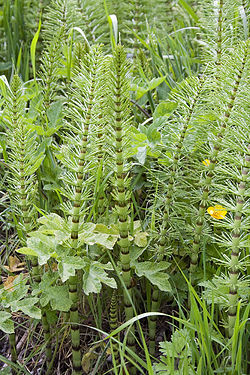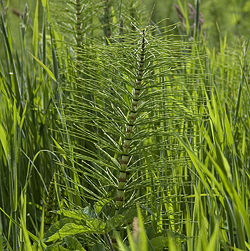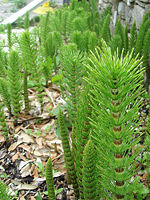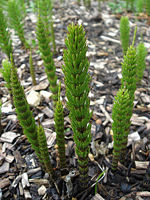Field horsetail
| Field horsetail |
|---|

|
| Scientific Classification |
|
| Binomial Name |
|
Equisetum arvense |
The field horsetail (also known as common horsetail) is a species of vascular non-flowering plants with the the scientific name of Equisetum arvense. The field horsetail has two types of stems- the sterile stem and the fertile stem. the sterile stem is green in color and the fertile stem is brown. The field horsetail also has two stages of reproduction - asexual and sexual. The asexual stage uses one rhizome for reproduction and the sexual stages have two different ways to reproduce. The field horsetail has specify rhizomes and tubers to live in many different places. Today the horsetail is used in many parts of our lives.
Anatomy
The field horsetail has two types of stem: sterile stems and fertile stems. Sterile stem is green but fertile stem is brown. The Sterile stem is erect, grows to 60cm tall, it has 3-5 mm diameter hollow stem (without branches)and although they have branches, they do not have leaves and sub branches. On the stem, we can easily see the many joints, colored is green and brown. [1] The joints contain sheaths for the branches (the sheath is the branch or leaves' base and its surrounding stem); also the sheath has 10-12 teeth. [2] The fertile stem has a different shape with sterile stem; The fertile stem grows to 30 cm tall and has light brown, brown and white color; also, it has 2-5 joints. On the top of the stem, we can see the cone, which is for reproduction.[3]The cone is egg shaped and brown; also, the surface of the cone has white and black dots which is spores. The fertile stem variety grows during mid spring but dies early when the cone spreads the spore. After the spores spread, we can see the sterile stem’s growth.[4]
Reproduction
The field horsetail has a two stages reproduction: asexual and sexual. The asexual stage is from the one rhizome, which is broken into many parts. Each part gets a place for development. During the winter, each part create new rhizome, then it will grow a new horsetail during the spring, which is the season of flowering. The sexual stages have two different ways to reproduce. The first way is through elaters and spores; the spores go into the soil through the elaters, which is a structure that forces the dispersal of spores. Then through propagule and prothalli, they get fertilization. The second way is through water and winter, the fertile stem’s cone has spores for the reproduction, so they spread them in the winter and by means of water. The spores can not live a long time but they can germinate in a moist place before they die. [5]
Ecology
The field horsetail has good rhizomes and tubers, and can live in many different places. The rhizomes can easily spread their new plants, so they can easily adapt to many environments. For example, they can live in wet forests, meadows, swamps, fens, alpine, savannas, prairies, seeps, ditches, railroads, in sand and with weed. [6] However, in pastures, hayfields, orchards and nurseries, they are uninvited guests. Because they make trouble for animals and their foods. The field horsetails have high levels of toxic alkaloids which is bad effect to horse, sheep and cattle. The toxic alkaloid is poison to them, and it invades swamps and sometimes changes the soil, enabling erosion. The horsetail is similar with herbicides to the soil, because of its high toxicity, the horsetail acts as a herbicide to other plants. [7]
Use
The horsetail is used in many parts of our lives. it can be used in medicine. People found silica from horsetail, so it is used to make medicine of diuretic and it helps relieve kidney stones and urinary tract infections. In addition it helps combat osteoporosis, because horsetails cause increasing bone density. In the 1970’s horsetails were used to make perfume, but today few people use them to make perfume. Also it is used for food flavors and flavor enhancers. [8]
Gallery
 Browse |
References
- Common Horsetail John Hilty. Illinois Wildflowers.
- Field Horsetail (Equisetum arvense) unknown Author. past management.
- Common Horsetail unknown Author. Publisher.
- Equisetum arvense Field Horsetail Earl J.S. Rook. Rook.Org.
- FIELD HORSETAIL unknown Author. Ohio Perennial & Biennial Weed Guide.
- Horsetail unknown Author. University of Maryland Medical Center
- Equisetum arvense L.unknown Author. USDA.







